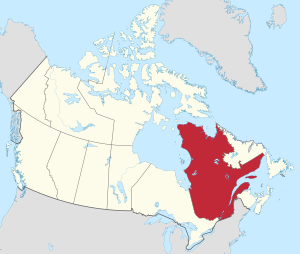
Back Quebec Afrikaans Québec (Provinz) ALS ኬበክ Amharic Québec AN Quebec ANG كيبك Arabic ܩܝܒܩ (ܗܘܦܪܟܝܐ) ARC كيبيك ARY كيبيك ARZ Québec AST
This article may be too long to read and navigate comfortably. When this tag was added, its readable prose size was 14,769 words. (June 2024) |
Quebec
Québec (French) | |
|---|---|
| Motto(s): | |
| Coordinates: 52°N 72°W / 52°N 72°W[1] | |
| Country | Canada |
| Before confederation | Canada East |
| Confederation | July 1, 1867 (1st, with New Brunswick, Nova Scotia, Ontario) |
| Capital | Quebec City |
| Largest city | Montreal |
| Largest metro | Greater Montreal |
| Government | |
| • Type | Parliamentary constitutional monarchy |
| • Lieutenant Governor | Manon Jeannotte |
| • Premier | François Legault |
| Legislature | National Assembly of Quebec |
| Federal representation | Parliament of Canada |
| House seats | 78 of 338 (23.1%) |
| Senate seats | 24 of 105 (22.9%) |
| Area | |
| • Total | 1,700,000 km2 (700,000 sq mi) |
| • Land | 1,365,128 km2 (527,079 sq mi) |
| • Water | 176,928 km2 (68,312 sq mi) 10.4% |
| • Rank | 2nd |
| 17% of Canada | |
| Population (2021) | |
| • Total | 8,501,833[2] |
| • Estimate (Q2 2024) | 9,030,684[3] |
| • Rank | 2nd |
| • Density | 6.23/km2 (16.1/sq mi) |
| Demonym(s) | in English: Quebecer, Quebecker, Québécois in French: Québécois (m),[4] Québécoise (f)[4] |
| Official languages | French[5] |
| GDP | |
| • Rank | 2nd |
| • Total (2022) | C$552.737 billion[6] |
| • Per capita | C$63,651 (9th) |
| HDI | |
| • HDI (2019) | 0.916[7]—Very high (9th) |
| Time zone | UTC−05:00 (Eastern Time Zone for most of the province[8]) |
| • Summer (DST) | UTC−04:00 |
| Canadian postal abbr. | QC[9] |
| Rankings include all provinces and territories | |
Quebec[a] (French: Québec [kebɛk] )[12] is one of the thirteen provinces and territories of Canada. It is the largest province by area[b] and the second-largest by population.
With an area of 1.7 million square km and more than 12,000 km of borders,[13] in North America, Quebec is located in Central Canada, the province shares land borders with provinces of Ontario to the west, Newfoundland and Labrador to the northeast, New Brunswick province to the southeast, and a coastal border with Nunavut, it's bathed up north by James Bay, Hudson Bay, Hudson Strait, Ungava Bay, Arctic and Atlantic Oceans, and in the south, its borders by the United States.[c]
- ^ "Quebec". Geographical Names Data Base. Natural Resources Canada.
- ^ "Population and dwelling counts: Canada, provinces and territories". Statistics Canada. February 9, 2022. Retrieved February 9, 2022.
- ^ "Population estimates, quarterly". Statistics Canada. September 27, 2023. Archived from the original on September 28, 2023. Retrieved September 28, 2023.
- ^ a b Fee, Margery; McAlpine, Janice (2001). Oxford Guide to Canadian English Usage. Oxford University Press. p. 335. ISBN 0-19-541619-8.
- ^ "Status of the French language". Government of Quebec. Archived from the original on May 14, 2011. Retrieved November 10, 2010.
- ^ "Quarterly indicators, Québec and Canada". Institut de la Statistique du Québec. September 20, 2023.
- ^ "Sub-national HDI - Subnational HDI - Global Data Lab".
- ^ See Time in Canada
- ^ "Canada Postal Codes". zippinpostal.com. Retrieved April 6, 2024.
- ^ Barber, Katherine, ed. (2004). "Quebec". The Canadian Oxford Dictionary. Oxford University Press. ISBN 9780195418163.
- ^ Jones, Daniel (2011). Roach, Peter; Setter, Jane; Esling, John (eds.). "Quebec". Cambridge English Pronouncing Dictionary (18th ed.). Cambridge University Press. ISBN 978-0-521-15255-6.
- ^ According to the Canadian government, Québec (with the acute accent) is the official name in Canadian French and Quebec (without the accent) is the province's official name in Canadian English "Geographical Names of pan-Canadian significance". Natural Resources Canada. Archived from the original on September 18, 2015.
- ^ "Geography of Quebec territory" (in French). Government of Quebec. March 28, 2024. Retrieved June 26, 2024.
Quebec is divided into 17 administrative regions which bring together 104 regional county municipalities (MRC) and several independent municipalities.
Cite error: There are <ref group=lower-alpha> tags or {{efn}} templates on this page, but the references will not show without a {{reflist|group=lower-alpha}} template or {{notelist}} template (see the help page).


